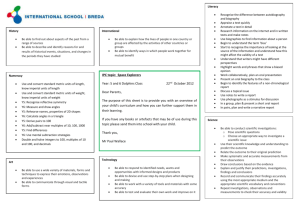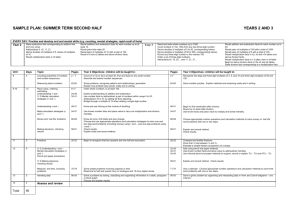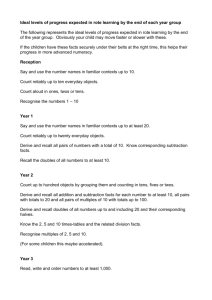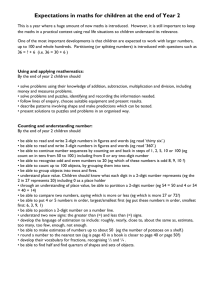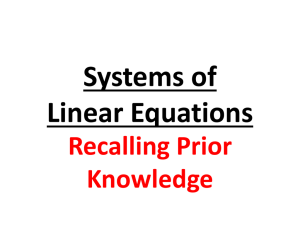Maths P2 - Finborough School
advertisement
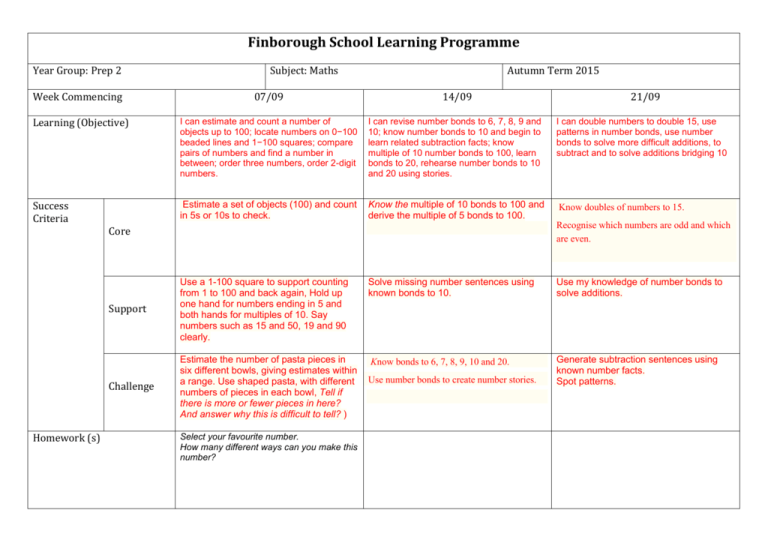
Finborough School Learning Programme Year Group: Prep 2 Week Commencing Subject: Maths Autumn Term 2015 07/09 14/09 21/09 Learning (Objective) I can estimate and count a number of objects up to 100; locate numbers on 0−100 beaded lines and 1−100 squares; compare pairs of numbers and find a number in between; order three numbers, order 2-digit numbers. I can revise number bonds to 6, 7, 8, 9 and 10; know number bonds to 10 and begin to learn related subtraction facts; know multiple of 10 number bonds to 100, learn bonds to 20, rehearse number bonds to 10 and 20 using stories. I can double numbers to double 15, use patterns in number bonds, use number bonds to solve more difficult additions, to subtract and to solve additions bridging 10 Success Criteria Estimate a set of objects (100) and count in 5s or 10s to check. Know the multiple of 10 bonds to 100 and derive the multiple of 5 bonds to 100. Know doubles of numbers to 15. Core Recognise which numbers are odd and which are even. Homework (s) Solve missing number sentences using known bonds to 10. Use my knowledge of number bonds to solve additions. Support Use a 1-100 square to support counting from 1 to 100 and back again, Hold up one hand for numbers ending in 5 and both hands for multiples of 10. Say numbers such as 15 and 50, 19 and 90 clearly. Know bonds to 6, 7, 8, 9, 10 and 20. Challenge Estimate the number of pasta pieces in six different bowls, giving estimates within a range. Use shaped pasta, with different numbers of pieces in each bowl, Tell if there is more or fewer pieces in here? And answer why this is difficult to tell? ) Generate subtraction sentences using known number facts. Spot patterns. Select your favourite number. How many different ways can you make this number? Use number bonds to create number stories. Finborough School Learning Programme Year Group: Prep 2 Subject: Maths Week Commencing 28/09 Autumn Term 2015 05/10 12/10 Learning (Objective) I can sort 2D shapes according to symmetry properties using Venn diagrams, identify right angles and sort shapes using Venn diagrams, recognise squares, rectangles, circles, triangles, ovals and hexagons, investigate which tessellate, sort shapes and objects using a two-way Carroll diagram. I can begin to mark numbers on a landmarked line, compare and order numbers, using < and > signs, work systematically to find all possible inequalities, find 1 and 10 more or less using the 100-square, find 10 more and 10 less than any 2-digit number I can add and subtract 10, 20 and 30 to any 2-digit number; Add and subtract 11, 21, 12 and 22 to any 2-digit number; Solve addition and subtractions by counting on and back in 10s then in 1s; solve addition and subtraction problems using concrete and pictorial representations. Success Criteria Sort 2D shapes into Venn diagrams using properties incl. symmetry. Find out whether shapes tessellate or not? Begin to mark numbers accurately on a landmarked line. Use reasoning to solve a number problem. Record findings in a table. Add 10, 20, 30 to 2-digit numbers by counting on in 10s. Understand how a Carroll diagram works. Core Support Challenge Homework (s) Find out whether shapes tessellate or not. Sort objects using a two-way Carroll diagram. Use < and > signs to compare numbers. Identify at least one two lines of symmetry. Sort shapes using a two-way Carroll diagram. Compare 2-digit numbers using the < and > signs. Understand how a Carroll diagram works. Create a two way Carroll diagram showing items from your bedroom. Are these items symmetrical or not symmetrical? Add multiples of 10p to amounts. Use a bead string to add 10 to any 2-digit number. Find a number in between two given 2-digit numbers. Use a dice and add and subtract 10 to each number on the dice in order to complete a game. Add and subtract multiples of 10. Finborough School Learning Programme Year Group: Prep 2 Subject: Maths Week Commencing Learning (Objective) Success Criteria 02/11 09/11 16/11 I can understand and use terms and vocabulary associated with position, direction and movement; Measure lengths using uniform units; Begin to measure in centimetres and metres Derive and recall multiplication facts for the 2, 5 and 10 times tables and the related division facts; recognise multiples of 2, 5 and 10. I can add and subtract 2-digit numbers; Solve addition and subtraction problems using concrete and pictorial representations; Add near doubles to double 15; Add several small numbers spotting near doubles or pairs to 10, etc. Derive and recall multiplication facts for the 2, 5 and 10 times tables and the related division facts; recognise multiples of 2, 5 and 10. Count on or back in 10s and 1s; Solve addition and subtraction problems using concrete materials and pictorial representations. Recall 2, 10 and 5 times tables. I can count in 2s, 5s and 10s from zero; Count in multiples of 2p, 5p and 10p; Number sequences of 2s, 5s and 10s; Find the totals of coins and ways to make an amount; Use coins to make given amounts of money. Derive and recall multiplication facts for the 2, 5 and 10 times tables and the related division facts; recognise multiples of 2, 5 and 10. Measure length of feet in centimetres. Core Autumn Term 2015 Recall 2, 10 and 5 times tables Count in 2s, 5s and 10s on the beaded number line? Begin to find how many 2s, 5s and 10s are in a given number? Recall 2, 10 and 5 times tables. Measure height in decimetres. Support Recall 2 times tables. Add two 2-digit numbers using a 100square or bead string to count on in 10s and 1s? Work out how many 2s or 5s are in a given number. Recall 2 times tables. Recall 2 times tables. Challenge Measure distance travelled in metres. Add three 1-digit numbers. Recall 2, 10 and 5 times tables. Recall 2, 10 and 5 times tables. Recognise multiples of 2, 5 and 10? Explain how to tell if a number is a multiple of 5. Recall 2, 10 and 5 times tables. Homework (s) Measure and list as many items as you can in your home that are 1m or under. Count the steps it takes you to get to different locations in your house from the front door. Finborough School Learning Programme Year Group: Prep 2 Subject: Maths Week Commencing Learning (Objective) Success Criteria Core Support 23/11 Autumn Term 2015 30/11 07/12 I can recognise and know the value of 1p, I can recognise and know the value of 1p, 2p, 5p, 10p, 20p, 50p and £1 coins. 2p, 5p, 10p, 20p, 50p and £1 coins. I can recognise and know the value of £2 coins and £5, £10, £20, £50 notes. I can recognise and know the value of £2 coins and £5, £10, £20, £50 notes. I can derive and recall multiplication facts for the 2, 5 and 10 times tables and the related division facts; recognise multiples of 2, 5 and 10. I can derive and recall multiplication facts for the 2, 5 and 10 times tables and the related division facts; recognise multiples of 2, 5 and 10. Combine amounts to make particular values; match different combinations of coins to make equal amounts of money. Recall 2, 10 and 5 times tables Use coins to solve simple problems involving addition, subtraction and giving change. Recall 2, 10 and 5 times tables Add two amounts of money without crossing into £s; use coins to solve simple addition problems. Recall 2 and 5 times tables. Recognise and use symbols for pounds and pence. Record amounts using £.p notation. Recall 2 and 5 times tables. Recognise and use whole, half and quarter turns, both clockwise and anticlockwise; know that a right angle represents a quarter turn. I can derive and recall multiplication facts for the 2, 5 and 10 times tables and the related division facts; recognise multiples of 2, 5 and 10. To read the time on a digital clock ending in :00 or :15 or :30 or :45 and then draw the hands on the analogue clock face to match. Recall 2, 10 and 5 times tables. Match digital and analogue times for the quarter hours. Recall 2 and 5 times tables. Challenge Homework (s) Add two amounts of money, beginning to cross into £s; use coins to solve simple addition problems. Recall 2, 10, 5 and 3 times tables. Measure family members. Does the tallest person in your family have the biggest shoes? Produce this information in a chart of your choice. Use coins and notes to solve simple problems involving addition, subtraction and giving change. Recall 2, 10, 5 and 3 times tables. Tell the time on an analogue and digital clock to the nearest quarter. Recall 2, 10, 5 and 3 times tables.

